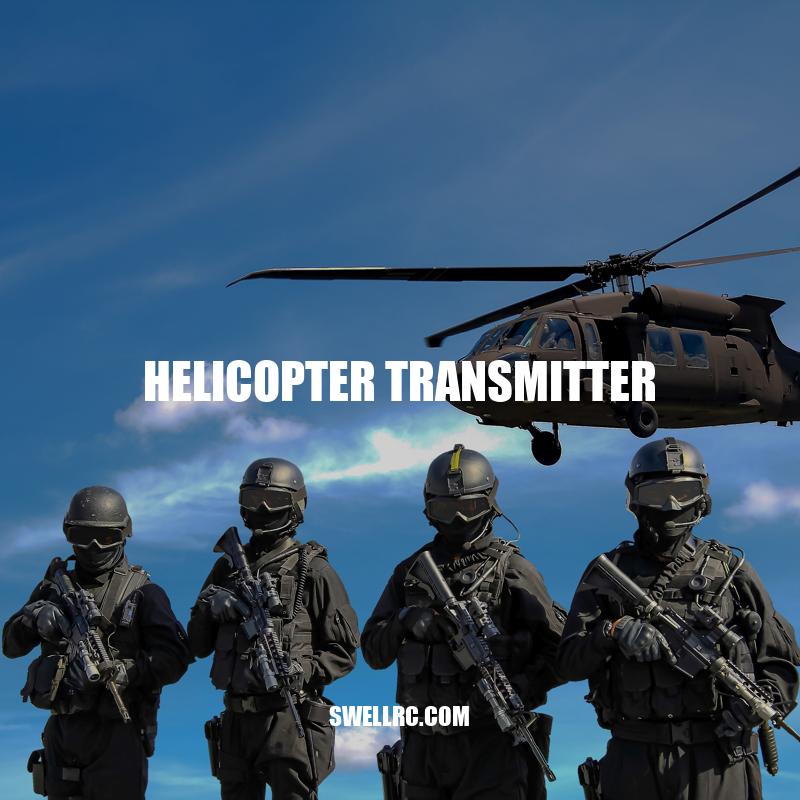Guide to Helicopter Transmitters: Importance, Types, and Advanced Features
A helicopter transmitter is one of the essential components of any helicopter communication system. It is responsible for sending and receiving signals between the helicopter and air traffic control towers, other aircraft, and ground stations. Pilots rely on helicopter transmitters to communicate vital information while in flight, such as their location, altitude, heading, and any changes in flight plans. Without a reliable and effective transmitter, communication between the helicopter and air traffic control can become dangerous, especially in high-traffic areas where other aircraft and weather conditions can impact a flight’s safety.
For this reason, it’s essential for helicopter pilots to have a deep understanding of the different types of transmitters available on the market and how to choose the one that’s best for their needs. Factors such as frequency range, signal strength, and resistance to interference are just a few of the critical components they must consider when selecting a transmitter. Additionally, pilots must ensure that their transmitter is correctly installed, maintained, and tested regularly to ensure it’s working correctly and can provide the level of safety needed during flight.
Overall, a helicopter transmitter is a critical piece of equipment for helicopter pilots. By investing in a reliable and effective transmitter and understanding how to use it correctly, pilots can help ensure the safety of their passengers and other aircraft in the skies.
Types of Helicopter Transmitters
There are various types of helicopter transmitters available on the market. Each type has its own advantages and disadvantages, and pilots must choose the right one based on their needs. The main types of helicopter transmitters include:
- VHF Transmitters: The most commonly used, these transmitters operate in the frequency range of 118 MHz to 137 MHz. They transmit clear voice signals over long distances and are reliable even in adverse weather conditions.
- UHF Transmitters: These transmitters operate in the frequency range of 225 MHz to 400 MHz. They’re useful for communication in areas where VHF frequencies may be congested or not available.
- Satellite Transmitters: These are useful for long-range communication and can be used in remote areas where traditional communication methods may not work.
- Datalink Transmitters: These transmitters are used to send digital data, such as weather information, to the helicopter cockpit.
Pilots must choose the transmitter that best suits their individual needs based on various factors such as the type of helicopter they are flying, the area they are flying in, and the type of communication they need. Some popular helicopter transmitter manufacturers are Bendix King, Garmin Avionics, and Cobham SATCOM. Before making a purchase, pilots may compare different products and their features on websites such as Avionics Source or Aircraft Spruce.
What factors should pilots consider when choosing a helicopter transmitter?
When it comes to choosing a helicopter transmitter, pilots should consider a number of factors to ensure they have the right equipment for the job. Firstly, the range of the transmitter is crucial. Pilots need to know that their radio communications will work throughout their intended flight path and in any circumstances that may arise, such as adverse weather conditions or interference from other radios.
Another consideration is the number of channels on the transmitter. Pilots need to make sure they have enough channels to accommodate all the necessary communication, such as air traffic control, other helicopters, and ground crews.
The type of modulation used in the transmitter is another factor to consider. Amplitude modulation (AM) can sometimes suffer from static interference, especially in areas where there are high levels of radio frequencies. In contrast, frequency modulation (FM) is more reliable and less prone to interference.
Battery life is also an important factor, as pilots need to be sure that their transmitter will last for the duration of their flight or mission and that they will not run out of power at a critical moment.
Finally, pilots should consider the size and weight of the transmitter as they often need to carry their equipment with them. A smaller and lighter transmitter will be more comfortable for the pilot and will not add unnecessary weight to the helicopter.
In conclusion, choosing the right transmitter for a helicopter is crucial to ensure smooth and safe communication during a flight or mission. Factors to consider include range, number of channels, modulation type, battery life, and size and weight.
Advanced Features of Helicopter Transmitters
Modern helicopter transmitters come equipped with advanced features that enhance communication and safety during flights. Some of the most commonly used features include:
- Noise Cancelling Technology: Blocks out background noise, allowing pilots to focus on incoming signals.
- Automatic Identification: Helps identify the caller or the aircraft communicating with the pilot.
- Frequency Scanning Capability: Allows the pilot to scan through various frequencies and identify the strongest one for communication.
- GPS Integration: Shows the helicopter’s location on a digital map, making it easier to navigate and communicate.
These advanced features have made helicopter transmitters more efficient, reliable, and safe than ever before. It’s interesting to note that even the military uses advanced helicopter transmitters for their communication needs. For instance, the U.S Army uses the High-Frequency Manpack Radio (HFMR) for long-range communication in remote areas.
In conclusion, pilots must choose the right type of helicopter transmitter based on their individual needs and ensure that it is properly installed and maintained. With advanced features such as noise-cancelling technology, automatic identification, frequency scanning capability, and GPS integration, helicopter transmitters have become more efficient, reliable, and safe than ever before.
What are some examples of advanced features in helicopter transmitters?
Helicopter transmitters are essential components that transmit signals from the controller to the helicopter’s receiver, allowing pilots to operate the helicopter. Advanced helicopter transmitters come equipped with features that enhance the piloting experience, making it easier to achieve smooth and precise flights while minimizing pilot error.
One example of an advanced feature found in helicopter transmitters is the ability to program custom flight modes. This feature allows pilots to create unique flight modes, assigning different control responses to specific stick movements. It enables pilots to tailor the helicopter’s response according to their flying style, improving precision, and accuracy during flight.
Another example of an advanced feature is the telemetry system. This feature provides pilots with real-time data on the helicopter’s performance, such as speed, altitude, temperature, voltage, and motor RPM. It allows pilots to monitor their helicopter’s performance and make adjustments to prevent damage or improve efficiency.
Helicopter transmitters can also come with GPS and navigation systems, allowing pilots to program the helicopter’s flight path and interact with other GPS-enabled devices. This feature is especially useful during long-range flights, where pilots need to maintain a consistent course to avoid obstacles or navigate unfamiliar terrain.
Other advanced features in helicopter transmitters that assist pilots during flight include wireless connectivity, voice alerts, fail-safe modes, and the ability to control multiple helicopters from a single transmitter.
In conclusion, advanced helicopter transmitter features go beyond standard piloting, enabling pilots to customize their helicopter’s behavior, monitor and adjust performance, use GPS for navigation, and interact with other smart devices. These advancements improve the overall efficiency, precision, and safety of helicopter operation.
Apart from VHF transmitters, there are other types of transmitters that helicopter pilots use for communication and safety purposes. Some of these types are:
- Emergency Locator Transmitters (ELTs): These are devices designed to transmit emergency signals in case of an accident, helping search and rescue personnel locate the downed helicopter.
- Personal Locator Beacons (PLBs): These are small and portable devices carried by individual pilots and can be activated to send SOS signals in case of an emergency.
- Multi-Function Displays (MFDs): These devices provide pilots with a wide range of data that includes flight plans, weather, and traffic information in real-time, making navigation and communication easier during flights.
ELTs and PLBs are critical safety devices that pilots must carry during their flights. Moreover, MFDs have become increasingly popular in recent years due to their advanced features and capabilities. Some of the most widely used MFDs in the aviation industry are the Garmin G1000 and the Honeywell Primus Epic.
In conclusion, helicopter transmitters come in different types and with various features that enhance communication and safety during flights. Pilots must understand the type of transmitter that they need based on their specific flying requirements and ensure that they have the necessary safety devices such as ELTs and PLBs. The use of MFDs has increased in recent years due to their advanced features and capabilities, allowing pilots to navigate and communicate with ease during flights.
What are the benefits of using Multi-Function Displays (MFDs) in helicopter communication and safety?
Multi-Function Displays (MFDs) in helicopters are becoming more and more common. The reason for this is simple. MFDs offer a range of benefits that improve communication and safety in a number of ways.
First and foremost, MFDs provide pilots with an intuitive and easy-to-use interface to access and display information. This means that pilot workload is reduced and efficiency is increased. MFDs can also display information in a variety of formats, including maps, charts, and graphs, which can help pilots to navigate difficult terrain and weather conditions.
In terms of safety, MFDs can provide pilots with real-time information about weather conditions, other aircraft in the area, and potential hazards. This information can help pilots to make informed decisions about their flight paths and avoid potentially dangerous situations.
Another benefit of MFDs is that they can be customized to meet the specific needs of each pilot or flight team. This means that pilots can choose the information that is most relevant to their needs, and display it in a way that is most useful to them.
Overall, the benefits of using MFDs in helicopter communication and safety are clear. With their intuitive interface, real-time information, and customizable features, MFDs can help pilots to safely navigate the skies and complete their missions with confidence.
Conclusion
In conclusion, helicopter transmitters are essential communication tools that are crucial in ensuring the safety and efficiency of any flight. They allow pilots to communicate with air traffic control towers, other aircraft, and ground personnel, making flying much safer and more manageable.
When choosing a helicopter transmitter, it is essential to consider the type of flying you plan to do and ensure that the transmitter has the necessary features to ensure safe communication during all types of flying conditions. The modern technology behind helicopter transmitters, including noise-cancelling capabilities, frequency scanning, and automatic identification, has made them more efficient, reliable, and safer than ever before.
It is also important to remember that there are other types of transmitters that pilots can use for communication and safety purposes, including ELTs, PLBs, and MFDs. With advanced features such as real-time data about flight plans, weather, and traffic information, these types of transmitters aid pilots in flying with greater ease and confidence.
In conclusion, a knowledgeable pilot must understand the importance of having a reliable helicopter transmitter and the necessary safety devices that come with it. It is the responsibility of pilots to ensure that they are appropriately trained in the use of helicopter transmitters, and that they are committed to continually expanding their knowledge and skills in this critical aspect of flying.



